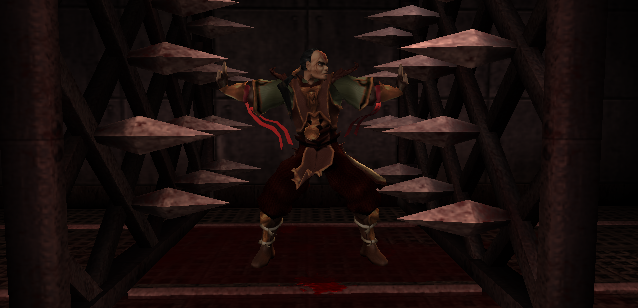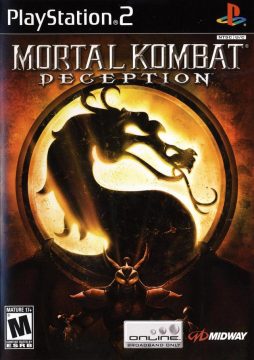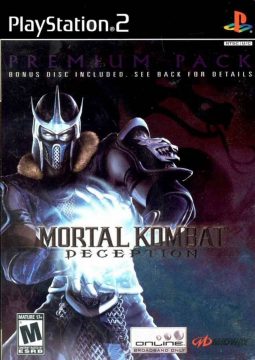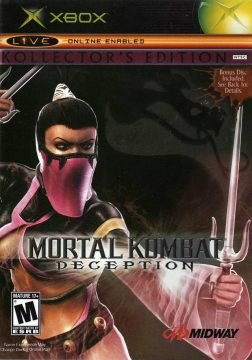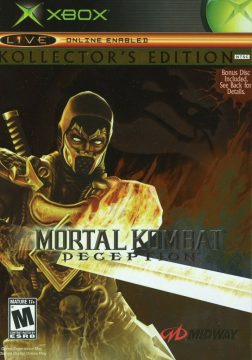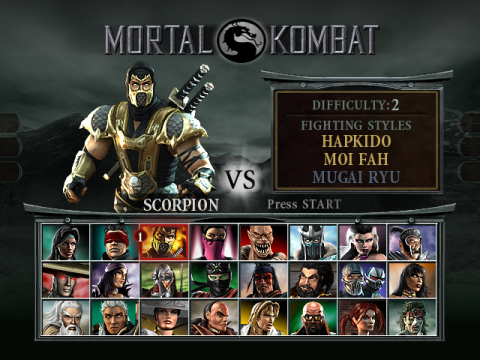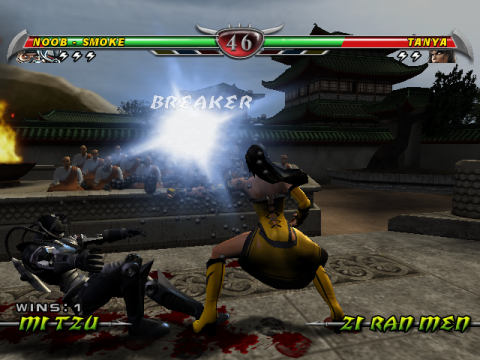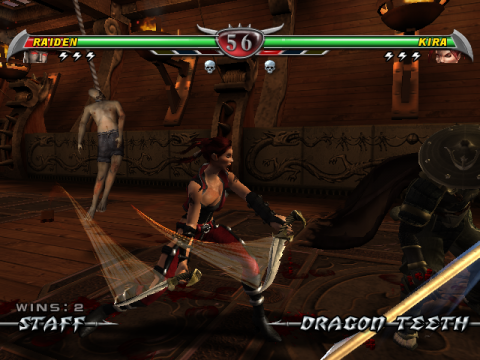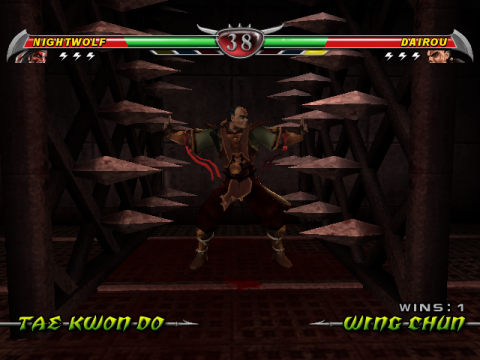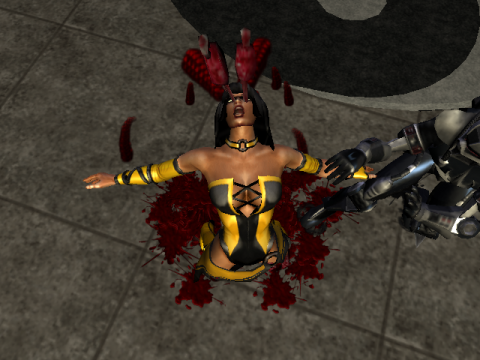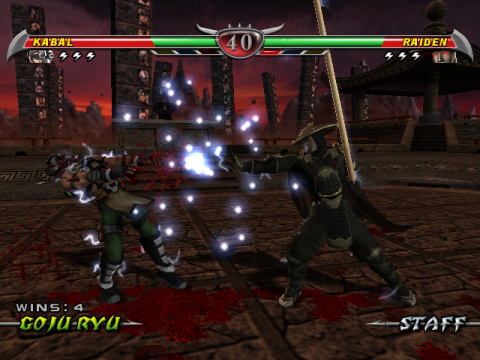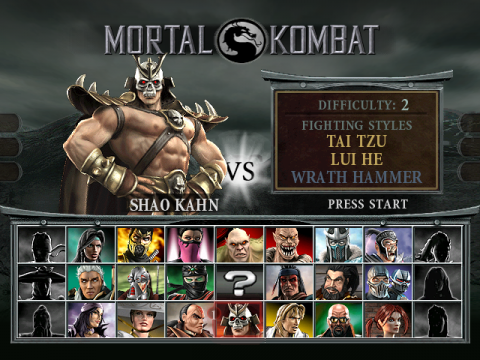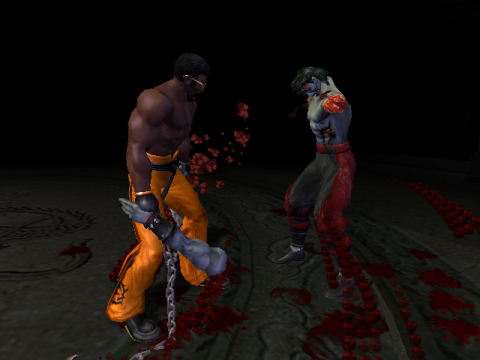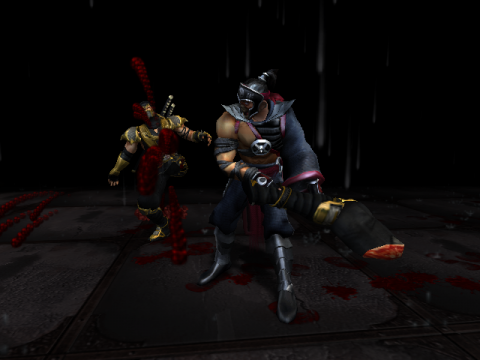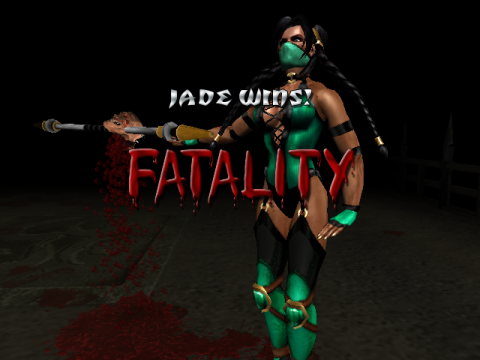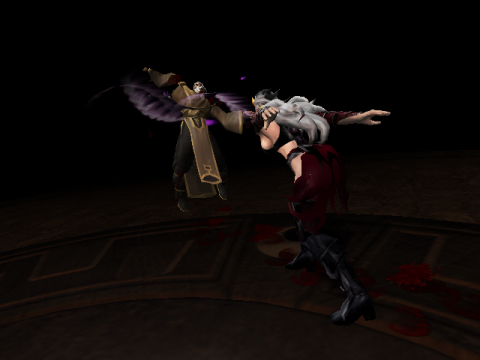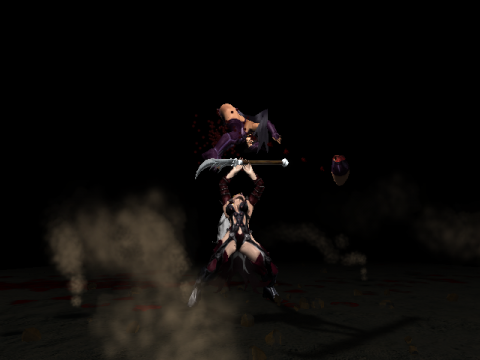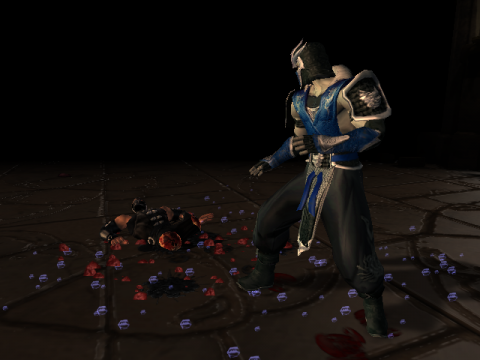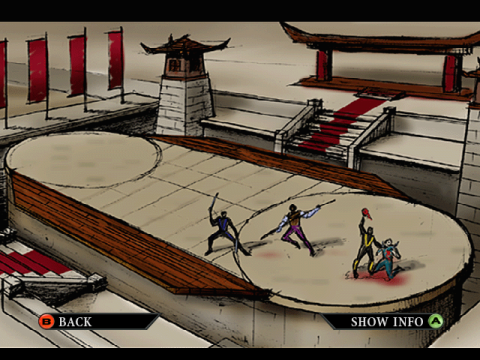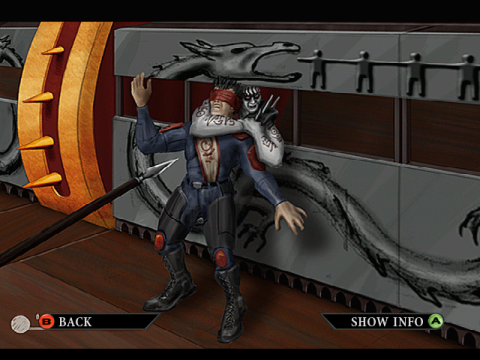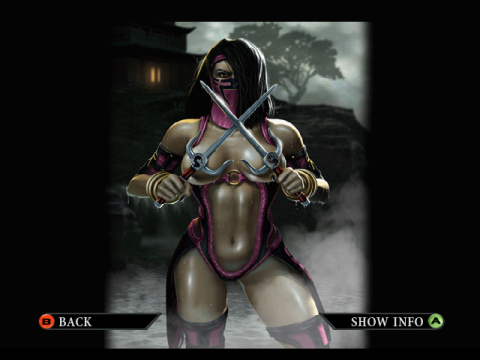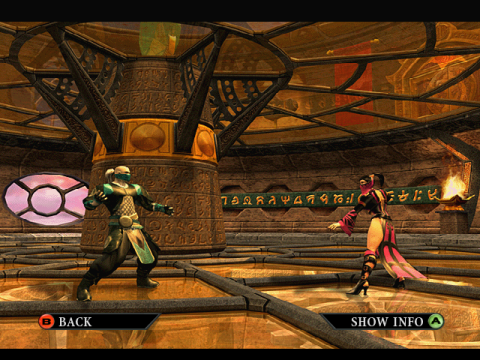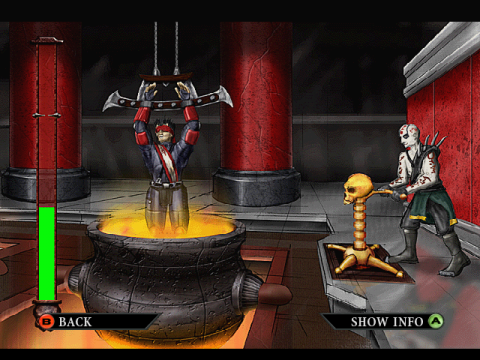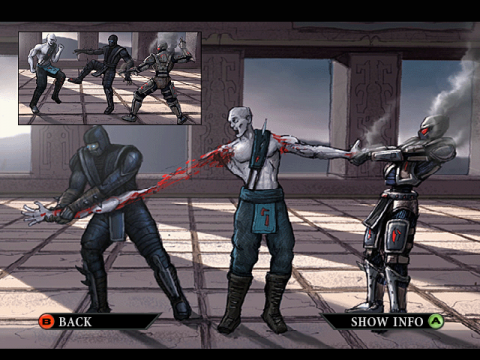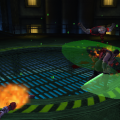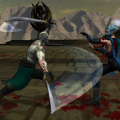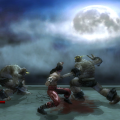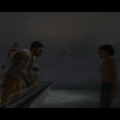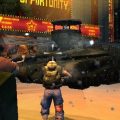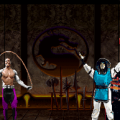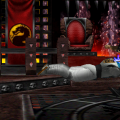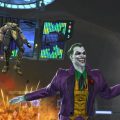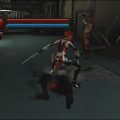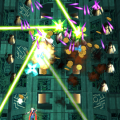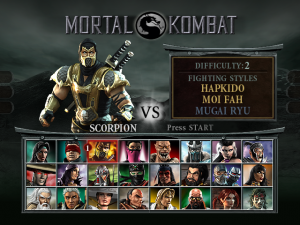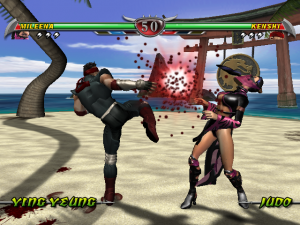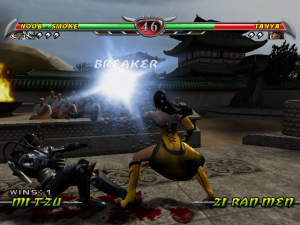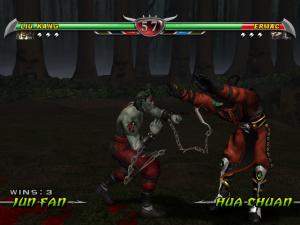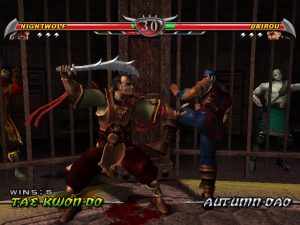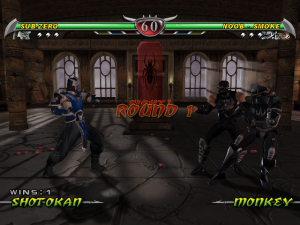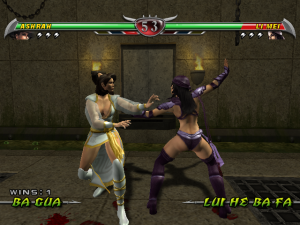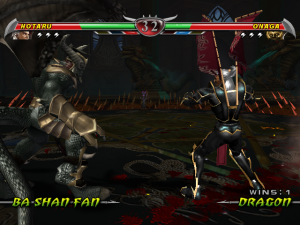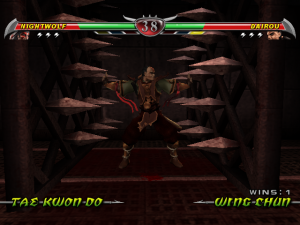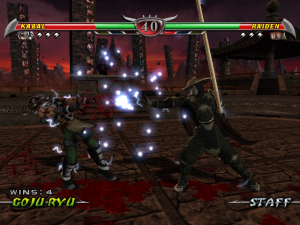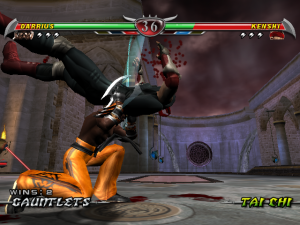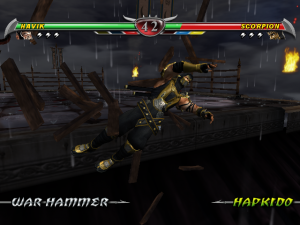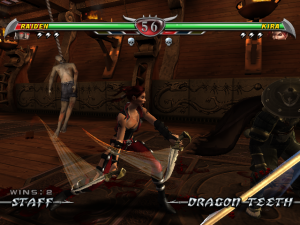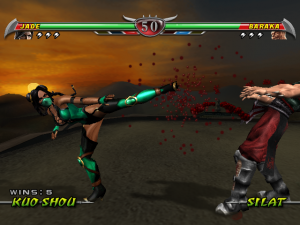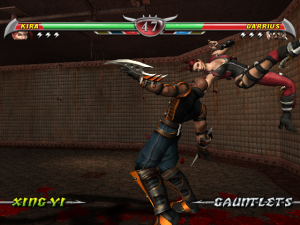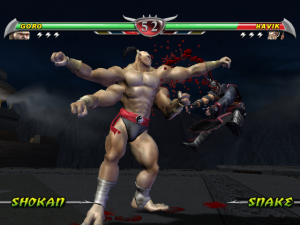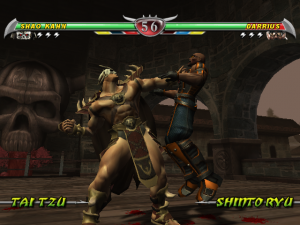- Mortal Kombat (Introduction)
- Mortal Kombat (1992)
- Mortal Kombat II
- Mortal Kombat 3
- Ultimate Mortal Kombat 3
- Mortal Kombat Trilogy
- Mortal Kombat 4
- Mortal Kombat Mythologies: Sub-Zero
- Mortal Kombat: Special Forces
- Mortal Kombat: Deadly Alliance
- Mortal Kombat Deception
- Mortal Kombat: Shaolin Monks
- Mortal Kombat Armageddon
- Mortal Kombat VS DC Universe
- Mortal Kombat (2011)
- Mortal Kombat X
- Mortal Kombat (Miscellaneous)
Compared to the likes of Special Forces, Deadly Alliance was a success, at least for the MK fans. It needed more polish, more content and more Fatalities, and a sequel was quickly underway to deliver all this and more. Deceptionis a major improvement over the shaky new mechanics in Deadly Alliance, but don’t expect this entry to replace Virtua Fighter 4 in your collection, either. It also gave us some of the most boring characters in the franchise. Don’t forget, we’re talking about the series that brought us Jarek, here.
Deception starts off not long after the events of Deadly Alliance, and things are getting real bad, real fast. For one thing, the Deadly Alliance won. Shang Tsung and Quan Chi have sent the Dragon King’s invincible army out after the heroes of Earthrealm, who quickly and fatally find out that they weren’t kidding about the ‘invincible’ part. While most of the heroes of Earthrealm are getting killed off, Raiden charges in to try and put a stop to the Deadly Alliance himself. He puts up a good fight, but the two manage to overpower him. At this rate, the only thing that could possibly stop Quan Chi and Shang Tsung now is if Onaga himself showed up. Guess what happens next?
Raiden and the Deadly Alliance are even forced to team up to try to take Onaga down, but nothing they try works. In a last resort, Raiden blows himself and the Deadly Alliance up, but it doesn’t even scratch Onaga. Onaga’s plan, now that there’s nobody to stop him, is to gather six artifacts known as the Kamidogu, which are apparently part of an omnipotent power known as the One Being. If the One Being awakens, it will merge all the realms into itself, which basically means it’ll destroy the universe. The good news is that Raiden survived blowing himself up, but now he’s super pissed. He’s put in so much effort protecting Earthrealm, and now that some idiot went out and resurrected Onaga, he’s going to protect the hell out of Earthrealm, whether they want it or not. And by protect, he means “Bring unlife to Liu Kang’s rotting corpse and use it as his own personal enforcer.”
As you can imagine from the way the story goes, things are even darker and gritter this time. You can tell even from the menus that this won’t be a happy game, with a thunderstorm going on in the background and the dark techno that plays over the character select screen. Speaking of characters, there’s actually a lot more than there were in the predecessor. Some of them return from Deadly Alliance, but there’s also quite a few characters who haven’t made an appearance in a “major” MK game since the 2D games, like Sindel and Baraka. And of course, there are a few new guys in there, too. Not that most of them are any good.
The basic fighting mechanics are mostly unchanged from Deadly Alliance. Everybody stills gets two fighting styles and one weapon. Many combos have been shortened down, with few that have more than about five hits. Some characters like Kenshi still have some insanely long combos for 10 inputs or more, though, if you happen to be a genius at memorizing things. If you get trapped in a combo, however, you’re not entirely screwed anymore. Hitting forward and block while you’re caught in a combo will let you use one of your “breakers,” represented by lightning bolts under your health bar. Using a break will knock your opponent away from you and end their combo. Unfortunately, you only get three per match. Not per round, per match. And you can’t recharge them, ever. They’ve also removed the style-specific moves, which means you can’t jab something into your opponent and wait for them to bleed to death anymore.
The arenas also have a bit more interactivity to them, compared to the flat shapes of Deadly Alliance. Midway has taken a page from Dead or Alive, and some parts of the stage are marked with glowing yellow borders. If you do a strong enough attack while your opponent is near this border, you’ll send them to another part of the arena, doing some extra damage in the process. There are other hazards besides the stage transitions, too. The Dark Prison stage, for example, has characters who aren’t playable in Deception, like Quan Chi, locked inside the cells. If you get too close to one of the prisoners, they’ll grab you and leave you open for your opponent’s attacks. Some stages also have unique weapons that any character can pick up and use.
Some parts of the stage, however, are marked red, and these are death traps. If you knock your opponent into one of these, they die in some horrible way, and you instantly win the round. Unlike stage Fatalities, these can be used at any point in the match, on any round. So, yes, if you knock an opponent off of a cliff, sending them falling to their death on a stalagmite, they still return for Round 2, perfectly unharmed. If the death traps were only available on a winning round, it wouldn’t be quite as dumb, but if you want them off, they stay off.
The sub-boss this time around is a tag team with Noob Saibot and Smoke. Unlike most MK subbosses, they’re actually hidden playable characters, so they aren’t as tough as your usual MK subboss. Mortal Kombat hadn’t really done a tag team at this point before, and the way it works is that Noob and Smoke get one fighting style each. Switching fighting styles will switch between characters, giving you access to the special moves of either. Thankfully, they both share the same health bar, which helps to balance out getting two characters in one.
Onaga himself puts up a decent fight, even though he’s not nearly as tough as Shao Kahn, or even Moloch. He is, however, not a complete a wuss like Shinnok. What makes him so bearable, compared to the more unfair bosses before them, is Onaga’s decision to place the Kamidogu around his arena, for whatever reason. Touching any of them will make them shatter, stunning Onaga so you can get some hits in on him. You only have six to work with per attempt on him, but it does help. He also gets whiny if you use low attacks on him, yelling “No kicking!” at you. Seriously. He’s also nice enough to get set on fire and explode for you, which Quan Chi and Shang Tsung didn’t even bother with.
Everybody gets two Fatalities again, which is nice compared to the single one everybody got in Deadly Alliance. Most of them are decent, like the one where Lei Mei goes Kenshiro on her opponent, although some do get pretty dumb. Like the one where Raiden ends up blowing himself up with his opponent. Somehow, just like Smoke blowing up the planet, this still means he wins. There’s also a new kind of finishing move called the Hara-Kiri, where you finish… er, yourself. If you put in the right combination before your opponent can do a Fatality, you’ll basically do a Fatality on yourself. You still lose, but at least you can deny your opponent the satisfaction of a Fatality. Or something. Most of these are pretty goofy, like Sindel doing a backflip, which ends with her landing on her face and breaking her neck. Or Ashrah spinning around so fast her body parts fly off. Or Bo Rai Cho becoming so full of gas he explodes. Raiden blows himself up again, which seems to be becoming a really bad habit for him.
The stages are pretty interesting, now that they’re more than just flat shapes for the characters to walk on. There’s some interesting level concepts in there, too, like the Ying Yang Island stage. It’s a stage that half of the time is a sunny island, with palm trees swaying in the breeze and upbeat steel drum music playing in the background. Every so often, however, the island switches over to an evil version of itself, with a harsh thunderstorm, the trees becoming giant serpents, and grungy sounding techno for the soundtrack. It’s a little distracting in practice, but it’s a cool idea. There is also the Falling Cliffs, where every so often, part of the arena will fall apart, giving you less and less room to work with, until it’s the smallest arena in the game. There are also a few arenas brought back from the 2D games, including the original pit, the Dead Pool, and the Living Forest. Thankfully, they’ve expanded the formerly narrow bridges in the first two stages so that you can actually move around without falling off.
There are also a couple of mini games added besides the main fighting modes, which the more cynical might say are supposed to make up for the shortcomings of the fighting engine. One of these is Puzzle Kombat, which is more or less ripped wholesale from Capcom’s Super Puzzle Fighter II Turbo. You pick a super-deformed version of one of twelve characters from the main game, and kombat your opponent with colored blocks. Just like Puzzle Fighter, what you do is gather up blocks of the same color and use a breaker icon to shatter them, dumping more blocks onto your opponent for them to deal with. While you play, the characters fight it out below, and the closer somebody is to losing, the closer they are to getting pushed into one of the death traps at either side of the screen. Each character also has a super meter that fills up when they destroy blocks, and once it’s full, they can use a special ability that either helps them or hurts their opponent. That’s right, they finally put supers in an MK game and they use them for the minigame. Puzzle Kombat is actually pretty fun, if you’re a fan of the genre and/or Puzzle Fighter, but if you’re a hardcore fan of Capcom’s version, you’ll probably find a lot of issues with how it plays.
There’s also Chess Kombat, where instead of aping Puzzle Fighter, the old computer game Archon is ripped off instead. Each player picks five characters for their team, each one making up the five classes that appear on the board. The Leader is the king, and if he dies, you lose. The two champions you get serve as the queens, with a full health bar and a free range of movement. The two sorcerers can only move diagonally, but they each get a set of spells that can help you or harm your opponent. The three Shifters move like Rooks, and they become whatever opponent they fight, unless they’re fighting another Shifter. The Grunts have the smallest amount of starting health and the lowest range of movement, but you get eight of them. Before the game starts, you also have the option to place an invisible trap somewhere on the board. If an enemy piece steps on a trap, they get blown way into the air, before crashing back into the ground in a bloody explosion.
Actually playing Chess Kombat is a lot like a cross between chess and Archon. If a piece tries to capture another piece, the game moves over to the main fighting engine for a single round. Any damage a piece sustains after a fight stays, but pieces can be healed with a certain spell, or by moving over a power square. Power squares fully heal a piece that moves over them for the first time, and give it a 25% health boost if it gets into a fight while occupying it. To win, you have to use one of your pieces to capture the opponent’s leader. Honestly, there’s not all that much strategy involved in Chess Kombat, and if you’re really good at the main game, you could probably beat the AI with just a few pieces. It’s an interesting concept, though, and one that should have definitely been revisited with a better fighting engine.
The biggest of the new modes, however, would have to be the newly revamped Konquest mode. On paper, it sounds like a fantastic idea. An open world RPG/adventure, where you, as a new combatant, get to explore the realms, see the major events of MK history, and meet and battle the kombatants. In actual practice, however, it doesn’t really work like that.
In Konquest mode, you take the role of a young boy named Shujinko, a student of Bo Rai Cho who would do anything to leave his village and be a hero in Mortal Kombat. After a few tutorials on the basic mechanics, a glowing ball of light named Damashi appears and offers Shujinko a quest to gather the Kamidogu and save the realms. Each of the six realms has a Kamidogu somewhere that Shujinko needs to complete his quest, and there’s usually a lot of rigmarole he’ll have to get through to actually earn it. For example, at one point, Bo Rai Cho wants you to go find his missing medallion. So you have to go talk to the fisherman he was drinking with. But it turns out a bandit took his key, so you have to go find him and punch him to get it. And it goes on like this. Some of the quests you’ll run across are at least kind of amusing. There’s one where you find an old man who’s complaining about a toothache, and wants you to find a way to fix it. How do you fix his tooth? You just punch him right in the face. Having dislodged his tooth, the old man happily repays you.
If you explore, though, you’ll run across things like koins to pick up, treasure chests that contain coins or keys, as well as other collectibles like music and videos. Some of these things will only appear at certain times of the game year, so there’ll often be a time when you have to sit and meditate, which speeds up the game clock immensely. But even though the game keeps track of time down to the month, day, and year, nothing in the plot will ever happen unless you make it happen. Which isn’t a bad thing, since it gives you all the time you need to putz around and collect stuff. You’ll also run across people who will offer you side quests, which usually involves finding a thing and bringing it to them for extra koins. It seems especially silly when the actual kombatants from the main game start making you do fetch quests. It’s hard to feel like a warrior of Mortal Kombat when Scorpion is making you do his errands. Sometimes, the kombatants will challenge you to a fight with some kind of condition applied to it. If you win, you get some koins out of it, and if you lose, Shujinko picks himself up off the ground with no real consequence. There’s absolutely no way to lose in Konquest mode; you just have to try whatever you’re doing again.
All you really do in Konquest mode most of the time is move from objective to objective. It’s not that difficult to find out where you’re supposed to go, since you’re given a compass that points directly to the giant green beam that points to exactly where you need to be going. Most of the objectives themselves are basically just tutorials, where the characters you meet will make you do the combos and special moves they tell you to do. When this happens, you actually become the character you’re training with, for whatever reason. For the most part, this is all that ever happens in the Konquest mode. Sure, you end up going to places like the Netherrealm, but still all you do is wander around and do tutorials, only everything is slightly redder than before.
It’s not even worth doing for the story, since most of the voice acting is terrible on an early Resident Evil level. It’s not like Shujinko is that interesting of a character, either, and he tells other characters “I will do as you ask” so often that it’s practically his catchphrase. Probably the most amusement you’ll get out of Konquest is the punch button, which you can use on anybody in the game. On most people, it’ll knock them out for several days, while others will block it and counterattack. If you punch one of the playable kombatants, they’ll pull you into a fight, although nothing will actually happen, whether you win or lose.
The problem with Konquest mode is that it’s just boring. It feels more like a glorified tutorial than the grand adventure it’s supposed to be presented as, and the worst part is you’re pretty much forced to comb through it to unlock anything of worth. Even worse, it turns out by the end that Damashi was just a projection of the Dragon King, who was using Shujinko to gather the Kamidogu for him. It’s hard to feel sympathy for a glowing ball of light whose name translates to something along the lines of “I am tricking you”. What’s worse is that in the main fighting mode, Shujinko starts with absolutely no special moves, and he has to actually find and unlock them in the Konquest mode to be able to use them. Not only that, but they’re all ripped off from the other characters. It should be mentioned, at this point, that apparently Shujinko was supposed to be the “next-generation Liu Kang”.
The Krypt returns, although a little smaller than the one in Deadly Alliance. The good news is that there are no more empty coffins, meaning anything you open will be guaranteed to at least have something in it. The bad news is that the coffins containing the major unlockables, like characters, costumes, and arenas, are locked. The keys to unlock them can only be found in the Konquest mode, which means you pretty much have to play it. And it still keeps the stupid koin denomination system from Deadly Alliance, along with the profile system, whatever it’s supposed to do.
Deception is a big improvement over Deadly Alliance, but not so much that many people would call it a great game. There’s a lot more content, the fighting mechanics have been tightened up, and the stage interactivity is nice. That is, when it isn’t being used against you for a cheap shot victory. Some of the issues with Deadly Alliance are still there, though, like the lack of character individuality, the fighting style gimmick, and the stiff controls. We still have one more game using the DA engine to go, and it’s going to be a big one…
While the PlayStation 2 and XBox versions are more or less identical, the GameCube port wouldn’t hit until 2005. Apparently, this was during a point when Midway wasn’t sure if they wanted to continue supporting Nintendo hardware, which explains the delay. Since the Gamecube doesn’t really do online without a lot of trickery, the online mode is missing. The trade-off, however, is that you get Goro and Shao Kahn as playable characters, although they’ve been weakened down to be on par with the rest of the cast. Apparently the Shao Khan who had died during Deadly Alliance was a magical clone or some such, and the real one has returned to try to take control of things once more. This version also unlocks half of the secret characters from the start, which means less time spent in Konquest mode. And that’s always an improvement.
The PSP version, renamed Mortal Kombat: Unchained, has Shao Kahn and Goro along with four characters from Deadly Alliance. Unfortunately, they’re copied and pasted straight from their original appearance, which means that they have the same exact move set, one Fatality, and no Hara-Kiri. It also has a new Endurance mode, if survival modes happen to be your thing.
Fatalities
Concept Art
